It’s tough being a tourist in Barcelona. There are so many things to see and do (for starters: the Gothic Quarter, Picasso museum, Gaudí buildings and other Modernist architecture) as well as so much that tempts to eat and drink (again, simply for starters: tapas and wine bars). Unless you have the good fortune of an extended stay, it’s impossible to take it all in.
So, what are the “must-see’s” during a short stay in Barcelona? I recently visited Barcelona, building an itinerary around the major sights as well as some markets and unique shops. Below are some tips for others who might be interested in doing the same.
Tip: Even for the briefest of stays in a city as dynamic as Barcelona, allotting time to explore the local markets enriches the experience. Sightsee as much of the astonishing architecture, art and other city treasures as you possibly can, but be sure that markets and unique shops also make it onto your itinerary.
Barcelona has 40 markets. Each district has at least one food market. The city has been investing in renovating its markets, as reported in this recent New York Times article. The best known of Barcelona’s food markets is La Boqueria. Friends and acquaintances urged me to see it, gushing, “Boqueria is the biggest, the best, the most unique….” Frankly, all the breathless praise made me suspicious. I imagined it as touristy and chaotic. And it is. It’s a magnet for camera-toting travelers as they stream in from the Ramblas. But it’s also quite authentic, especially once you get past the high-priced juice drinks near the entrance. The market isn’t only for tourists; locals adore and support it too.
Tip: La Boqueria market is open every day except Sunday, 8 am to 8 pm, although it slows down considerably after 4 pm. To see La Boqueria at its bustling best, visit on a Saturday morning when many of the locals are doing their rounds. The least interesting day is Monday because many fish stalls are closed and fewer shoppers come out.
La Boqueria has a crowded, carnival-like atmosphere. Bright lights beam from overhead. People angle for the limited seating. Tourists elbow in for camera shots while some merchants look on wearily. (More about that shortly.) So, what’s the big draw? 1) Gleaming displays of fresh fruits and vegetables, meats, olive oils, fish, breads, sweets….everything is displayed as if preparing for a Broadway opening. 2) The quality and broad selection. 3) The emphasis on local and seasonal items. 4) Stall vendors’ expertise. 5) Good eateries inside and alongside the market. 6) The opportunity to participate in a local shopping tradition that dates to the 12th century.
Some local specialties are fish preserved in salt, fresh-caught Mediterranean fish and shellfish, olives and olive oils, saffron, and of course Jamón Ibérica. Tomatoes dangle in long tresses. Locals buy them in bulk. They are used in a typical local dish called pa amb tomàquet: Cut slices of crusty bread, rub it with tomato, and drizzle olive oil on top. It sounds familiar, but when using local ingredients it tastes different…and divine.
Tip: The best local olive oil, with a complex and fruity flavor, is made from arbequina olives.
Tip: For the ultimate in cured ham, look for Jamón Ibérico de Bellota. That indicates a noble black pig that has been roaming oak forests and feasting on acorns (bellota) for at least the last three months of its life. You’ll pay more for this variety, but it’s one of those splurges that’s worth it. The dark red meat is marbled with veins of fat and has a sweet, nutty flavor. It tastes best when served in thin hand-cut slices on a warmed plate that permits the ham to “sweat.” The slight melting of fat ensures the ultimate flavor.
Prices are higher at Boqueria (as well as other neighborhood markets) compared to regular supermarkets, but the unique setting and history, tremendous selection and quality, and knowledgeable vendors more than make up for it. Another part of the appeal are the eateries. There are numerous opportunities to chow down on fresh market fare right on the spot.
Tip: Buy a paper cone filled with freshly sliced Jamón Ibérica and graze as you wander among the stalls, or sidle up to a stool at the counter at Pinotxo Bar where you might be served by Juan who is one of the market’s most beloved characters. Go early and enjoy breakfast. Or relax at Kiosko Universal which serves vegetable and seafood dishes. Restaurant la Gardunya also offers meals made with fresh ingredients at fair prices.
The Petras stand is well regarded for its mushrooms, herbs, edible flowers and other produce. It was the tail end of the season for zucchini flowers, but theirs were fresh and colorful. Fruits i Verdures Mercedes is another produce vendor with high quality.
Tip: Morning is the best time to go. See the displays when they’re at the freshest, the market at its relative calmest, and enjoy a hearty Spanish “spoon and fork breakfast.” Try the tortilla española, a local version of a potato omelette.
Ask locals about the prepared foods, and you’ll learn that one of the most appreciated is cooked beans. Not many people can afford the long prep time that’s required to cook beans from scratch. So this is one of Barcelona’s concessions to fast food. The flavor of the cooked beans sold at market is far superior to the canned variety.
As unique as La Boqueria is, there are many other markets in Barcelona that offer outstanding quality, freshness and selection – and without the crowds. If you can squeeze in a visit to one of them, do so. It’s a much calmer and, in many ways, more satisfying experience.
Santa Caterina market, for example, has a superb selection of quality local foods. Located in the trendy El Born neighborhood, Santa Caterina is said to be the oldest covered market in Barcelona. Like La Boqueria, it was built on the grounds of a former convent. Its contemporary roof, which is decorated with colorful mosaics, seems to undulate. Some of Barcelona’s other neighborhood markets include Concepcío market in the Eixample neighborhood and La Llibertat in Gràcia.
Tip : Visit La Boqueria market, but also shop at one of the other smaller neighborhood markets. It’s easier to appreciate the items up close without the camera-wielding crowds.
Tip: Speaking of cameras, ask permission before taking photos. If you don’t speak Catalan, catch the vendor’s eye, hold up your camera and ask the universally understood “OK?” before you start snapping away. And whenever possible, support those vendors whose displays inspire you by making a purchase of some kind.
Tip : A market tour and cooking class is a great way to immerse yourself in the pleasures of the local foods and wines. I was very pleased with a class that I took at BCN Kitchen, which I’ll cover in another post.
The markets of Barcelona are different from the food markets in Paris. Most of the Barcelona markets are covered structures whereas in Paris most markets are open-air. The Barcelona markets are usually open 6 days a week. In Paris, most markets are open only one or two days of the week. Barcelona’s markets feature local specialties that aren’t readily found elsewhere such as Iberian hams, arbequina olives and olive oils, and Spanish saffron. But there are some similarities between the markets of Barcelona and the markets of Paris: The quality and selection are excellent. It’s a glimpse into the food customs and culture, and unmatched as a way to taste the fresh local foods. And there are some rules of etiquette that should be respected.
Tip: Don’t touch the produce. (Important tip when shopping in the Paris food markets too.) You might see people violating this left and right. Don’t be one of them. Respect the local ways of shopping.
In addition to the neighborhood food markets, Barcelona has other kinds of markets. Encants Barcelona is a flea market with antiques, clothing, electrical goods, and other miscellaneous items. There’s a section of Las Ramblas where florists are concentrated, making it a virtual flower market. For secondhand books, the Sant Antoni market on Sundays is your best shot.
Along with the many markets of Barcelona, there are plenty of shops with local specialties and other merits. (“Plenty,” that is, at least for the moment. The suspension of rent control threatens the future of some of Barcelona’s unique shops, as reported in a recent New York Times article.) A few shout-outs for some of the shops:
Granja M. Viader for chocolate milk, hot chocolate, and other milk sweets
Jamón Experience to learn about jamon
Escribà for elegant pastries
Gelaaati di Marco for well-made Italian gelato
Casa Gispert for roasted nuts
La Botifarraria de Santa Maria for sausages
Bubo for modern interpretations of pastry
Vila Viniteca for superb cheeses and wines
Ganiveteria for scissors, knives and other cutting instruments
Café el Magnifico for coffee
One of the most memorable gastronomic meals I had was at Hisop. Their wildly creative concoctions hit the mark.
Details:
La Boqueria is located at La Rambla, 89 bis, in the center of Barcelona. Website: www.boqueria.info. This write-up about La Boqueria offers a bit more description. The closest subway stop is Liceu (the L3 line).
Mercat Santa Caterina is located at Francesc Cambó, 16 in the El Born neighborhood of central Barcelona. The closest subway stop is Jaume I (the L4 line). Here’s my short write-up about Santa Caterina market.
Concepció market is at Arago, 311 bis in the Eixample neighborhood. The closest stop is Girona (L4 line).
Llibertat market is located at place Llibertat, 27, in the Gràcia neighborhood.
The Encants Barcelona flea market is located at Plaça de les Glòries in the Eixample neighborhood. It’s open Monday, Wednesday, Friday and Saturday from 9 am – 8 pm. Tip: A public auction is held on Monday, Wednesday, and Friday mornings. Arrive by 7 am if you’re interested in attending the auction. Website: www.encantsbcn.com.
Sunday market of Sant Antoni is at Comte d’Urgell, 1 bis, in the Eixample neighborhood. Closest subway stop is Sant Antoni (L2 line).
BCN Kitchen is located at Calle Fusina, 15 (Born neighborhood). Their classes offer a fun way to experience the local food culture.
Barcelona Tourism offices are located throughout the city. You can also sign up for guided tours.
Le Cool Barcelona is a refreshing guide for some weird and wonderful cultural highlights.
Acknowledgements: I couldn’t have learned (or eaten) as much as I did in so little time if it weren’t for Rais Esteve from BCN Kitchen and Mònica Suri from Barcelona Guide Bureau. Rais shared even more insights after my visit, which helped me hone my observations. Thank you!
Related Posts:
La Boqueria (Barcelona)
Santa Caterina market (Barcelona)
10 Tips for Shopping at El Rastro flea market in Madrid
Highlights of Andalusia, Spain
Paris Food Markets: What Are the Different Types?

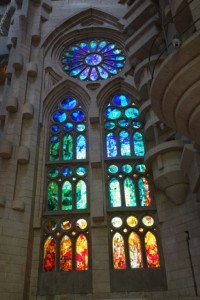
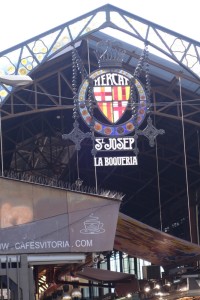
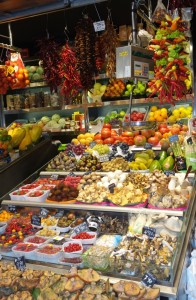
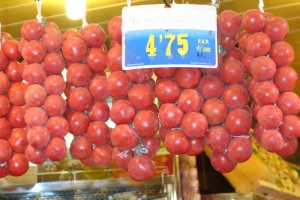
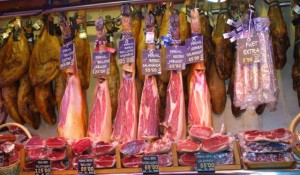

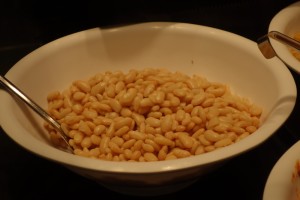
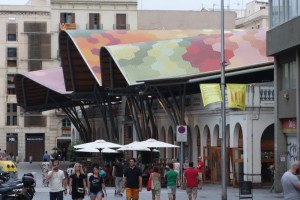

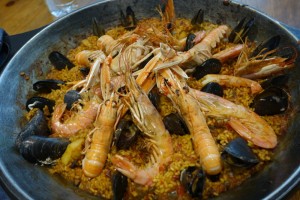
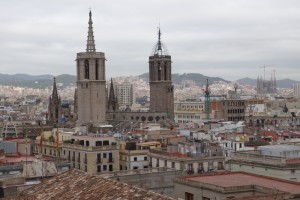
5 comments. Leave new
What a wonderful blog post! An excellent overview, useful specifics, and great tips. I only wish I’d had this with me before we went to Barcelona this year. Ah well, I guess we’ll just have to go back. Thank you, Marjorie!
Yes, do!
Oh Marjorie you make me yearn to return to Barcelona! As it happens, the daily photo I put up on our Music and Markets Facebook page today was jamon from the Boqueria! I’m going to add a link to this evocative blog post.
Where are you off to next?
Thank you, Anne. I saw your mouth-watering photo–nicely done. We obviously have many interests & appetites in common!
Thank you, Anne! 🙂